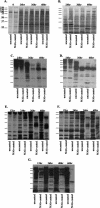Further characterization of immunomodulation by a monoclonal antibody against Streptococcus mutans antigen P1
- PMID: 14688075
- PMCID: PMC343944
- DOI: 10.1128/IAI.72.1.13-21.2004
Further characterization of immunomodulation by a monoclonal antibody against Streptococcus mutans antigen P1
Abstract
We demonstrated previously that mucosal immunization of mice with Streptococcus mutans coated with the monoclonal antibody (MAb) 6-11A directed against the major surface adhesin protein P1 results in changes in the amount, isotype distribution, and specificity of serum antibodies compared with animals immunized with bacteria only. We now show that the specificity of the mucosal secretory IgA response was also influenced by this MAb. Changes in antibody specificity were associated with changes in biological activity. Serum samples which differed in antibody reactivity with P1 polypeptides generated by partial digestion with N-chlorosuccinimide but not in isotype distribution or overall reactivity with S. mutans or intact P1 demonstrated a statistically significant difference in the ability to inhibit bacterial adherence to salivary-agglutinin-coated hydroxyapatite beads. Serum IgG antibodies against P1 from mice immunized with either S. mutans alone or S. mutans coated with 6-11A were shown to recognize antigenic determinants dependent on the presence of the central proline-rich repeat domain, a segment necessary for the structural integrity of the molecule. However, no statistically significant differences were observed in antibody reactivity with a panel of six partial P1 polypeptides encoded by overlapping spaP subclones, suggesting that the targets of biologically relevant antibodies involve complex epitopes not reconstituted by the recombinant products tested. Lastly, we show that binding of MAb 6-11A to P1 on the surface of S. mutans alters P1's susceptibility to proteolytic digestion. Hence, changes in antigen processing and presentation may contribute to the immunomodulatory effects of this MAb.
Figures






Similar articles
-
Redirecting the humoral immune response against Streptococcus mutans antigen P1 with monoclonal antibodies.Infect Immun. 2004 Dec;72(12):6951-60. doi: 10.1128/IAI.72.12.6951-6960.2004. Infect Immun. 2004. PMID: 15557617 Free PMC article.
-
Characterization of the Streptococcus mutans P1 epitope recognized by immunomodulatory monoclonal antibody 6-11A.Infect Immun. 2004 Aug;72(8):4680-8. doi: 10.1128/IAI.72.8.4680-4688.2004. Infect Immun. 2004. PMID: 15271929 Free PMC article.
-
Monoclonal antibody-mediated modulation of the humoral immune response against mucosally applied Streptococcus mutans.Infect Immun. 2000 Apr;68(4):1796-805. doi: 10.1128/IAI.68.4.1796-1805.2000. Infect Immun. 2000. PMID: 10722566 Free PMC article.
-
Beneficial immunomodulation by Streptococcus mutans anti-P1 monoclonal antibodies is Fc independent and correlates with increased exposure of a relevant target epitope.J Immunol. 2009 Oct 1;183(7):4628-38. doi: 10.4049/jimmunol.0803300. Epub 2009 Sep 14. J Immunol. 2009. PMID: 19752237 Free PMC article.
-
Secretory immunity in defense against cariogenic mutans streptococci.Caries Res. 1999;33(1):4-15. doi: 10.1159/000016490. Caries Res. 1999. PMID: 9831775 Review.
Cited by
-
An intramolecular interaction involving the N terminus of a streptococcal adhesin affects its conformation and adhesive function.J Biol Chem. 2013 May 10;288(19):13762-74. doi: 10.1074/jbc.M113.459974. Epub 2013 Mar 28. J Biol Chem. 2013. PMID: 23539625 Free PMC article.
-
Reconstruction of a pathway of antigen processing and class II MHC peptide capture.EMBO J. 2007 Apr 18;26(8):2137-47. doi: 10.1038/sj.emboj.7601660. Epub 2007 Mar 29. EMBO J. 2007. PMID: 17396153 Free PMC article.
-
Antibody-mediated immunomodulation: a strategy to improve host responses against microbial antigens.Infect Immun. 2005 Feb;73(2):671-8. doi: 10.1128/IAI.73.2.671-678.2005. Infect Immun. 2005. PMID: 15664904 Free PMC article. Review. No abstract available.
-
An intramolecular lock facilitates folding and stabilizes the tertiary structure of Streptococcus mutans adhesin P1.Proc Natl Acad Sci U S A. 2014 Nov 4;111(44):15746-51. doi: 10.1073/pnas.1413018111. Epub 2014 Oct 20. Proc Natl Acad Sci U S A. 2014. PMID: 25331888 Free PMC article.
-
Requirements for surface expression and function of adhesin P1 from Streptococcus mutans.Infect Immun. 2008 Jun;76(6):2456-68. doi: 10.1128/IAI.01315-07. Epub 2008 Mar 24. Infect Immun. 2008. PMID: 18362133 Free PMC article.
References
-
- Berzofsky, J. A. 1983. T-B reciprocity. An Ia-restricted epitope-specific circuit regulating T cell-B cell interaction and antibody specificity. Surv. Immunol. Res. 2:223-229. - PubMed
-
- Bouige, P., S. Iscaki, A. Budkowska, A. Cosson, and J. Pillot. 1997. Interest of immunomodulation as a means to improve the preparation of polyclonal and monoclonal antibody reagents. J. Immunol. Methods 200:27-37. - PubMed
-
- Bowen, W. H., B. Cohen, M. F. Cole, and G. Colman. 1975. Immunization against dental caries. Br. Dent. J. 139:45-58. - PubMed
-
- Brady, L. J., D. G. Cvitkovitch, C. M. Geric, M. N. Addison, J. C. Joyce, P. J. Crowley, and A. S. Bleiweis. 1998. Deletion of the central proline-rich repeat domain results in altered antigenicity and lack of surface expression of the Streptococcus mutans P1 adhesin molecule. Infect. Immun. 66:4274-4282. - PMC - PubMed
Publication types
MeSH terms
Substances
Grants and funding
LinkOut - more resources
Full Text Sources
Miscellaneous

